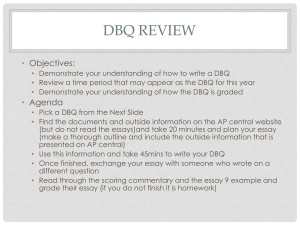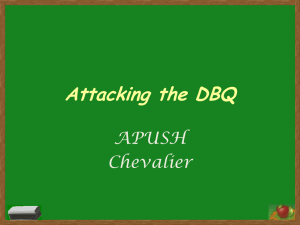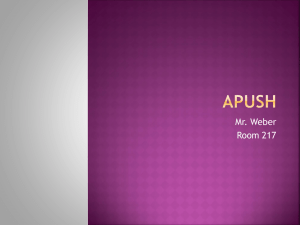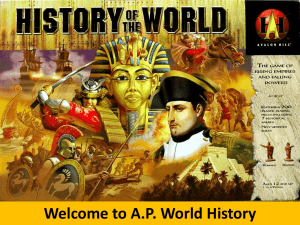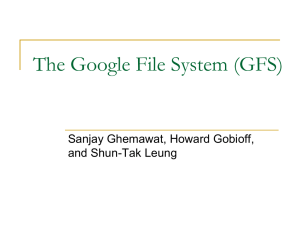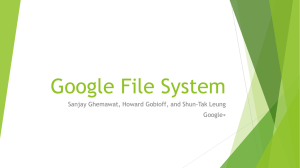Common Core Strategies for Your Classroom (NCSS13 presentation)
advertisement
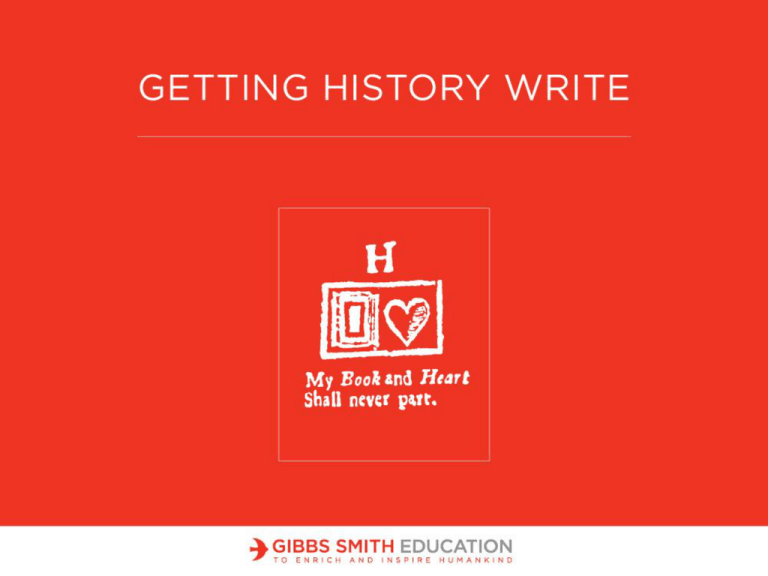
Kate Coombs • Curriculum Director for Gibbs Smith Education • Taught for Los Angeles Unified School District for 14 years • Spent 4 of those years as a teacher advisor/trainer • Taught K–3rd in an elementary setting • Taught 1st–12th for home-hospital school • Has also taught college English • Children’s book author • Lives in Utah but does not ski Handouts Galore Fortunately, a stronger writing program will benefit your own objectives as a history teacher. General William T. Sherman Underline the most intriguing sentence in what you wrote. Writing Tasks that Build on Student Ideas • Reader response to primary source without prompts • Reader response to primary source with prompts • Texted/written dialogue about a history topic and then create 5 intriguing ideas or questions to share • 1-page opinion piece (about a history topic or a historic figure’s key decision) + mini research task • Chunk writing in groups (see Chunk Writing below) • Historic op-ed piece—start with historic newspapers Analytical Reader Response Questions • In your own words, explain General Sherman’s reasons for not canceling the evacuation of Atlanta. What were his goals? Why? • Some people think General Sherman did not care what happened to citizens in a war. Argue for or against that opinion using evidence from Sherman’s letter (W.7.9). • Civilians always get hurt in a war zone. For example, in the Iraq War, more than 100,000 civilians were killed. (And 4,800+ troops from the US and other countries were killed.) Is it possible for civilians to be better protected? If so, how? • Some people are against all wars, while others are in favor of certain wars. When is war justified? What are some reasons wars are fought? Can war be avoided? Should it be avoided? DBQ’s: Not Just for Assessment • Students will have a more productive experience using Document-based Questions for projects instead of just for essay exams. • Also have students come up with their own DBQ’s, DBQ’s for each other, and class DBQ’s. • Students should discuss what makes a good DBQ. Which questions are less successful, and why? Writing Assignment Example 1. Have half the class read General Sherman’s letter and write the letter they think the mayor and city council must have written. 2. Have the other half read the mayor and city council’s letter and then write a letter from General Sherman turning them down. How would he respond to each point they made? 3. Give students the actual letters to read and discuss in connection with their own writing. 4. Follow up with a class discussion. 5 Myths about Student Writing 5 Myths about Student Writing 1. The 5-paragraph essay trains good writers. 2. Outlining in advance produces good writing. 3. Telling students to be more specific works wonders. 4. Plagiarism is about dishonesty. 5. Marking all conventions errors along the way means students will stop making them. The 5-Paragraph Essay: Fundamental Teaching Tool? Myth Buster #1: Five-Paragraph Panic I panicked the first time I had to write a real paper. What did that even mean? Writing a 10-paragraph essay? —Breeann Allison Clone Wars The 5-paragraph essay tends to produce stiff, underdeveloped writing. It is useful for writing essay exams, but is unlike any other writing out there, including college-level academic writing. My 9th grade English teacher told us, “You may think the 5-paragraph essay is limiting and restricting—and it is. But that’s too bad. That’s what you’re going to do. That’s life, doing things we don’t want to do.” —Breeann Allison 10-Page Skater Paper Chunk Writing STEP #1—Students brainstorm about topics and choose 6–8 ideas they really like that have potential for development. STEP #2—Students make brainstorm lists for their top 3 topics and see which one takes off. STEP #3—Students meet in pairs to come up with 3–4 more ideas for their lists about #1. Chunk Writing, cont. STEP #4—Students pick any subtopic from their lists and write 1–2 paragraphs about it. STEP #5—Students repeat this step in random order once per day till they have a “chunk” of writing for each idea on the list. But—WHAT ABOUT THE OUTLINE? Myth Buster #2: I-A-1-a-b-c-2… Outlining in advance locks students in, discouraging critical thinking and revision. Organize after Chunk Drafting STEP #6—Students lay out their chunks of writing in a logical order. They actually think about how the ideas should flow. (W.6–8.1a and 2a) STEP #7—Students add transitions as needed: “What words, phrases, or sentences, if any, are needed to get from the idea at the end of this paragraph to the idea at the beginning of the next paragraph?” (More thinking! W.6–8.1c and 2c) Myth Buster #3: Be Specific! Most students are unclear on what this means. Filming and Specificity Compare levels of specificity to filming and lens types, from wide angle to zoom. Models for Levels of Detail Level 1—Out of Focus (No detail: vague summary and abstract language) Level 2—Wide-Angle Lens (Teaser detail: summary with details/examples mentioned) Level 3—Medium Lens (Basic detail) Level 4—Zoom Lens (Developed detail) [Level 5—Super Zoom (1st person experience)] Using the Models • Train your students to refer to the levels of detail in class work. • Students should practice identifying abstract words (ideas and feelings) versus concrete words (can be experienced with the senses). • Concrete language can be general or specific—e.g., animal vs. chihuahua. • Encourage the use of concrete, specific language as well as examples and details. Grab Your Readers Ask students: How do details keep readers from getting bored? Uses for Different Levels of Detail • Level 1 should be avoided—it’s vague and boring! • Level 2 can be used for introducing and wrapping up ideas, also transitions. • Level 3 should be used for supporting details and examples. • Level 4 is used for extended examples and historic accounts. Revision: Add Details STEP #8—Have students add details using their own ideas and examples as well as peer feedback… (Research comes later.) “What else?” and “Tell me more!” Give them time. Chunk their work again. Myth Buster #4: A Plague of Plagiarism Credit Where Credit’s Due STEP #9—Have students add details using research material. • Save major research till later in the process. • Teach that research can support student ideas rather than obliterate them. • Use models and practice to teach the differences between quoting, paraphrasing, and summarizing. • Have students read and then put away research sources before paraphrasing. Thomas Jefferson once said, “I hold it that a little rebellion now and then is a good thing, and as necessary in the political world as storms in the physical.” How would you put it? Quote: Thomas Jefferson once said, “I hold it that a little rebellion now and then is a good thing, and as necessary in the political world as storms in the physical.” Bad Paraphrase: Thomas Jefferson once said that a small rebellion every so often is a positive thing that is as necessary in the political world as storms are in the physical world. Quote: Thomas Jefferson once said, “I hold it that a little rebellion now and then is a good thing, and as necessary in the political world as storms in the physical.” Good Paraphrase: According to Thomas Jefferson, a rebellion can sometimes clean up the political world the way a storm can clean up the natural world. Why do teachers often focus on convention errors? The Trouble with Tribbles Myth Buster #5: Red Pens at the Ready Addressing all convention errors every step of the way distracts students from developing their ideas. It also gets teachers off track. The red ink approach simply does not work. In the traditional model, students make the same mistakes year after year, taking them with them to college. Error Trends at the Very End • Save feedback about conventions till the very end, after content is developed and revised. • Choose one major error trend to focus on and ignore the rest—for now (e.g., run-on sentences). • Have each student practice finding that error. • Only move on to the next error trend after a student has improved on the first one. Thank you for being in love with history! Build History Thinkers by Building History Writers “History cannot give us a program for the future, but it can give us a fuller understanding of ourselves, and of our common humanity, so that we can better face the future.”
